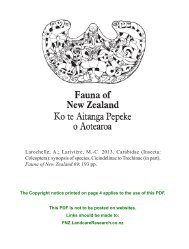PDF File, 693.8 KB - Landcare Research
PDF File, 693.8 KB - Landcare Research
PDF File, 693.8 KB - Landcare Research
Create successful ePaper yourself
Turn your PDF publications into a flip-book with our unique Google optimized e-Paper software.
What’s New In Biological Control of Weeds Issue 48 May 2009<br />
Table 2: Excerpt from framework<br />
9. Habitat Score Weight<br />
Aquatic/wetland Higher probability of success. 10 3.5<br />
Terrestrial Lower probability of success. 4 3.5<br />
Table 3: Top 20 Australian weed targets for biocontrol<br />
Rank Weed<br />
Likely<br />
Biocontrol<br />
Impact<br />
Weed<br />
Importance<br />
Eff ort<br />
Total<br />
Impact ×<br />
Importance<br />
× 1/Eff ort<br />
1 Spartina anglica 90.00 62.34 21.00 267.16<br />
2<br />
Alternanthera<br />
philoxeroides<br />
100.00 67.53 26.00 259.74<br />
3 Cabomba caroliniana 100.00 79.65 38.00 209.61<br />
4<br />
5<br />
6<br />
Chrysanthemoides<br />
monilifera<br />
Solanum<br />
elaeagnifolium<br />
Macfadyena<br />
unguis-cati<br />
64.00 84.85 26.00 208.86<br />
100.00 51.08 25.00 204.33<br />
77.00 64.94 26.00 192.31<br />
7 Prosopis spp. 50.00 99.13 26.00 190.64<br />
8 Ulex europaeus 56.00 70.13 21.00 187.01<br />
9 Tamarix aphylla 59.00 77.92 26.00 176.82<br />
10 Schinus terebinthifolia 76.00 59.74 26.00 174.63<br />
11 Parkinsonia aculeata 62.00 100.00 38.00 163.16<br />
12 Nassella neesiana 52.00 78.35 26.00 156.71<br />
13 Nassella trichotoma 52.00 77.06 26.00 154.11<br />
14<br />
15<br />
Genista<br />
monspessulana<br />
Hymenachne<br />
amplexicaulis<br />
59.00 52.38 21.00 147.17<br />
85.00 82.68 48.00 146.42<br />
16 Rubus fruticosus agg. 48.00 93.07 31.00 144.11<br />
17 Anredera cordifolia 76.00 50.65 28.00 137.48<br />
18 Salix spp. 75.00 77.49 43.00 135.16<br />
19 Argemone ochroleuca 59.00 35.50 17.00 123.20<br />
20 Thunbergia grandifl ora 76.00 64.50 40.00 122.55<br />
data become available. Methods for<br />
ranking weed importance also need<br />
further debate. Should new weeds<br />
of currently limited importance, that<br />
are known to be serious weeds in<br />
other countries, be attibuted a higher<br />
weighting compared with widespread<br />
medium-inportance weeds that have<br />
been around for ages? Also, how do<br />
we factor in the likely infl uences of<br />
climate change on weed distribution<br />
and abundance?<br />
While it is helpful to have tools like<br />
this framework to guide us in our<br />
decision making, we believe that<br />
some pragmatic decision making<br />
should also always be used when<br />
deciding on a portfolio of targets<br />
for biocontrol. While it is tempting<br />
and sensible to pick off some of the<br />
easier targets fi rst, there may be<br />
good reasons for embarking on some<br />
higher risk projects, such as when<br />
other eff ective control methods are<br />
lacking for a very serious invader.<br />
“After all, a 5% reduction in a really<br />
important weed doesn’t sound like<br />
much, but can result in economic<br />
or environmental benefi ts that<br />
outweigh the complete control of a<br />
minor weed,” added Quent.<br />
While developed initially for Australia<br />
this framework could be used to<br />
rank weed biocontrol targets for<br />
New Zealand or any other country.<br />
However, before this could happen a<br />
lot of data would need to be collated,<br />
especially on the importance of<br />
each weed and the likely ease of<br />
undertaking a biocontrol project.<br />
This project was funded by Land and<br />
Water Australia as part of the Australian<br />
Government’s Defeating the Weed<br />
Menace Programme. A full report on<br />
this project is available from www.lwa.<br />
gov.au/weeds<br />
7
















